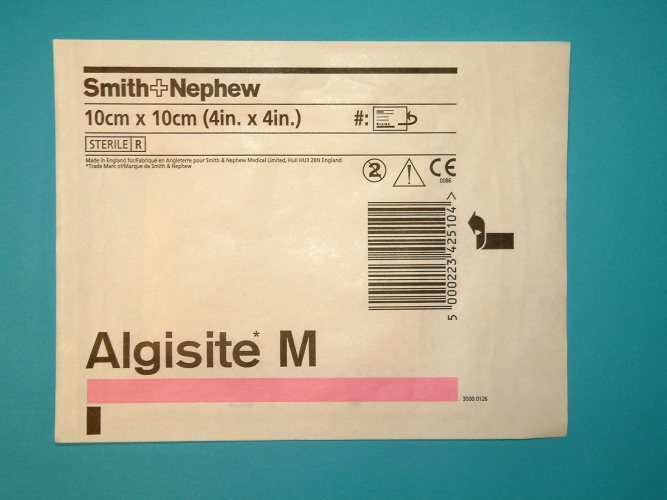
| Product Name: | Algisite M |
| Classification Name: | Calcium Alginate Primary Wound Dressing |
| Manufacturer: | Smith & Nephew Healthcare Ltd |

Algisite M is a primary wound dressing made from the calcium salt of alginic acid rich in mannuronic acid. It is prepared as a textile fibre held together by a special needle bonding process , and presented as a `rope' for packing for cavities, and a flat non-woven pad for application to larger open wounds. When in contact with serum, wound exudate, or solutions containing sodium ions, the insoluble calcium alginate is partially converted to the soluble sodium salt, and a soft, hydrophilic, gas permeable gel is rapidly produced, which conforms to the contours of the wound and provides a micro-environment that is believed to facilitate wound healing.
Algisite M sheets may be applied to exuding lesions including leg ulcers, pressure areas, donor sites, and most other granulating wounds but for deeper cavity wounds and sinuses, the rope packing form is generally preferred. The dressing also appears to be of value as an adjunct to the systemic treatment of infected or malodorous wounds and for the management of painful wounds when removal of other more traditional dressings causes unacceptable levels of pain or trauma.
Although there are no known contra-indications to the use of Algisite M, the dressing will be of little value if applied to wounds that are very dry, or covered with hard black necrotic tissue.
An Algisite M dressing, chosen to be slightly larger than the area of the wound, is placed in intimate contact with the wound base. Any overlap may be cut away or folded back over the wound surface before the application of a sterile secondary dressing held in place with surgical tape or a bandage as appropriate. The nature of the secondary dressing will be governed by the condition of the wound. If large quantities of exudate are anticipated, a simple absorbent dressing pad may be required; but as the wound heals and less exudate is produced, a thinner pad bearing a plastic film of low adherence may help to conserve moisture and prevent the wound drying out too quickly. Deeper cavity wounds or sinuses may be dressed with Algisite M rope, which should be placed gently in position but not packed in too tightly.
Because of the needling process used in its construction, the dressing has significant wet strength, which means that it can be easily removed from a wound in one piece, a process that may be facilitated by irrigation with sterile normal saline. This may be accomplished without causing either damage to the wound or pain to the patient. A small percentage of patients experience a mild `drawing' or `burning' sensation immediately after the application of an alginate dressing to a dry wound bed. This sensation, which is usually transient, is thought to be due to the hydrophilic nature of the dressing causing temporary localised drying of the surface of the wound. This discomfort may generally be prevented by moistening the surface of the wound with a small quantity of sterile normal saline prior to the application of the dressing.
The interval between dressing changes will depend entirely upon the state of the wound and the nature of the secondary dressing. Algisite M applied to heavily exuding or sloughy wounds may need replacing daily initially, but as healing progresses and the amount of exudate decreases, the interval between changes may be extended to up to 7 days in some circumstances. At this stage a change to an alternative dressing such as a film product should be considered to conserve moisture.
Wounds that show signs of clinical infection may be dressed with Algisite M but the dressing should be changed daily and the use of systemic antibiotic therapy considered
The dressings are presented individually packed in peel pouches, sterilised by ethylene oxide.
Algisite M is available in a range of sizes as follows.
Ankle circumference (Colour Code)
5cm x 5cm
10cm x 10cm
15cm x 20cm
2g x 30cm rope
1. Thomas, S., 2000, Alginate dressings in surgery and wound management - part 1: Journal of Wound Care, v. 9, p. 56-60.
2. Thomas, S., 2000, Alginate dressings in surgery and wound management - part 2: Journal of Wound Care, v. 9, p. 115-119.
3. Thomas, S., 2000, Alginate dressings in surgery and wound management - part 3:
4.Timmons J. Alginates and hydrofibre dressings. Prof Nurse 1999;14(7):496-9, 501, 503.
Further information on obtaining Smith & Nephew products is available on the
Smith &Nephew web site.
| Revision Author | Dr S. Thomas |
| Revision No | 1.5 |
| Revision date | 2006/01/23 |
This datacard has been prepared from data provided by the manufacturer and/or from published literature.